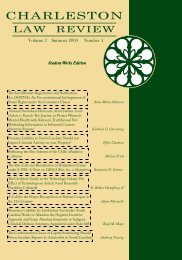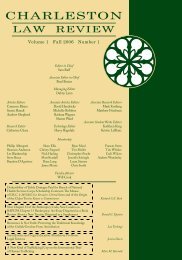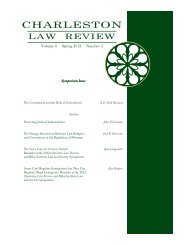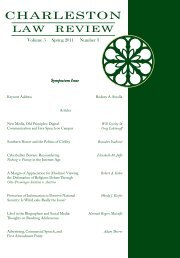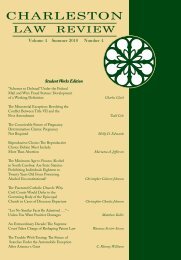Volume 5 Winter 2011 Number 2 - Charleston Law Review
Volume 5 Winter 2011 Number 2 - Charleston Law Review
Volume 5 Winter 2011 Number 2 - Charleston Law Review
Create successful ePaper yourself
Turn your PDF publications into a flip-book with our unique Google optimized e-Paper software.
<strong>2011</strong>] Errors in Judgmentof the numerous notice requirements contained in theCode. 53What impact, if any, does failing to follow the Rules preciselyhave upon a debtor if in fact the creditor did receive actual noticeof the bankruptcy through some mechanism? The noticerequirements specifically state that notice has to be “brought tothe attention of such creditor,” 54 and failure to notify the creditoraccording to a reasonable procedure established by the creditor“shall not be considered to have been brought to the attention ofsuch creditor until such notice is received . . . .” 55 How doescommunications sent to the debtor with the current account number of thedebtor and the address at which such creditor requests to receivecorrespondence, then any notice required by this title to be sent by the debtor tosuch creditor shall be sent to such address and shall include such accountnumber.”).53. See also Andrew P. MacArthur, Pay to Play: The Poor’s Problems in theBAPCPA, 25 EMORY BANKR. DEV. J. 407, 448–49 (2009) (discussing noticeprovisions in the BAPCPA).The BAPCPA [Bankruptcy Abuse Prevention and ConsumerProtection Act of 2005] dded multiple notice requirements. First, anynotice given to a creditor requires the debtor's name, last four digits ofhis or her taxpayer identification number, and address. Second, if inat least two communications within ninety days of the debtorinitiating a voluntary case the creditor provides the debtor with anaddress and account number, then the notice must be sent to theaddress provided and contain the account number. Third, in chapters7 and 13 cases, if a creditor files a notice of address with the court anddebtor, then the debtor must send any notices to that address effectivefive days after receiving that notice of address.The fourth notice requirement is similar to the third, but itinvolves chapter 7 and 13 cases pending in the courts and providesthat the debtor must use the creditor's notice of address effectivethirty days after receipt rather than five days. Fifth, § 342(c) was“amended to remove the old provision that . . . a failure by the debtorto supply notice to creditors in the prescribed form did not invalidatethe notice.” Finally, for notice to be effective, the notice has to beprovided in accordance with § 342 or “brought to the attention” of thecreditor. If the creditor has established a procedure that isreasonable, then notice that does not comply with that procedure isnot considered to be brought to the attention of the creditor.Id. (internal citations omitted) (omission in original).54. 11 U.S.C. § 342(g)(1) (2006).55. Id.205



